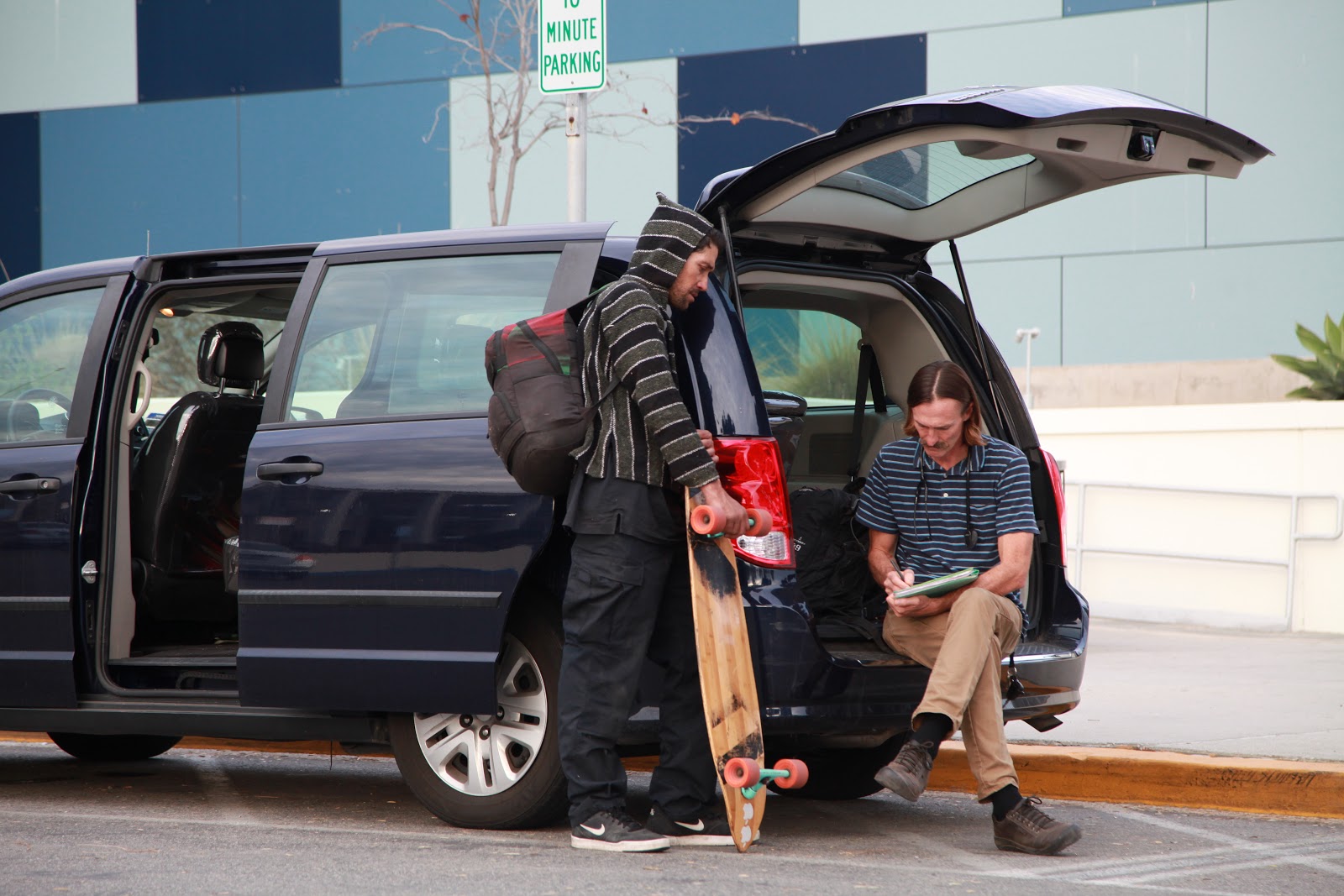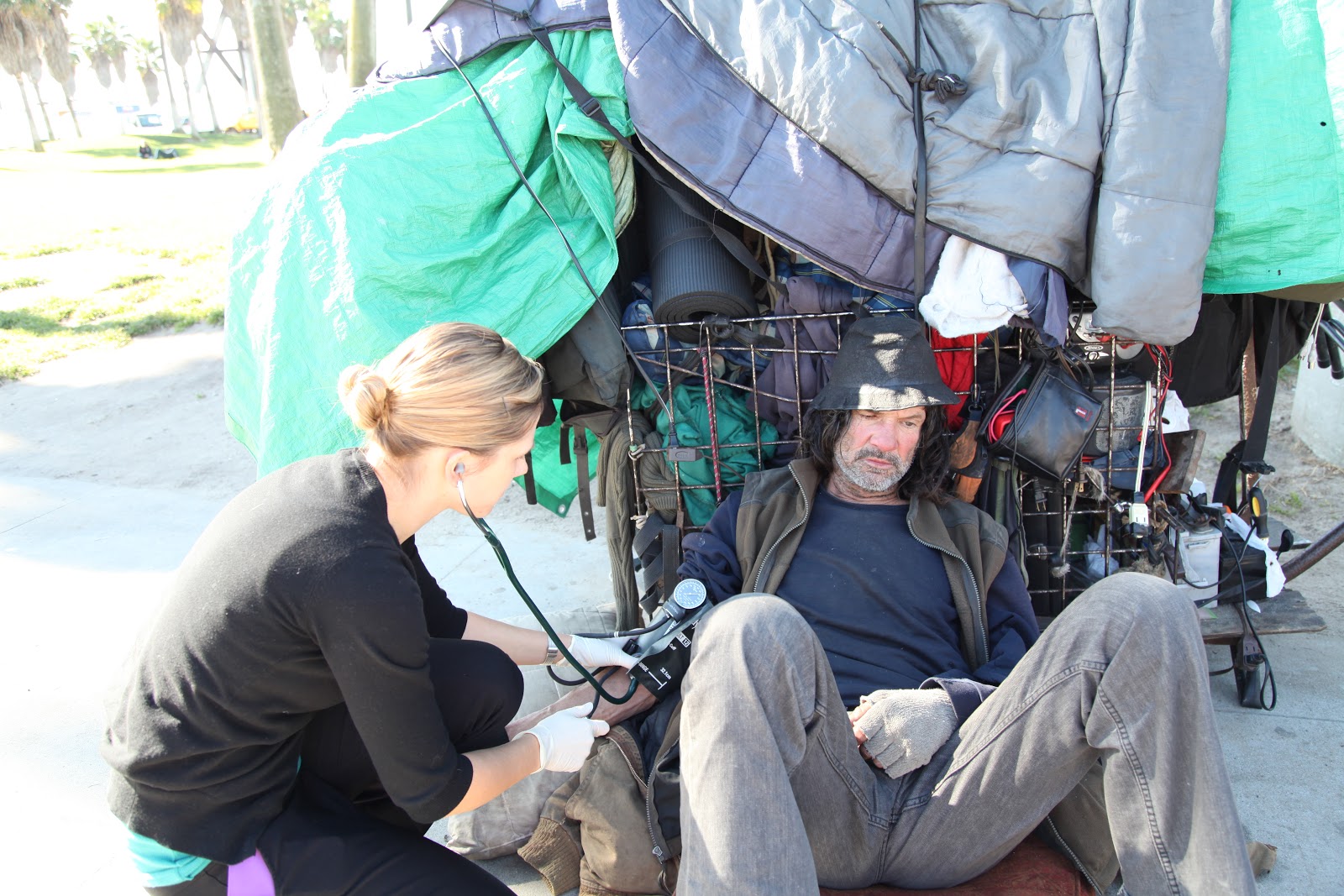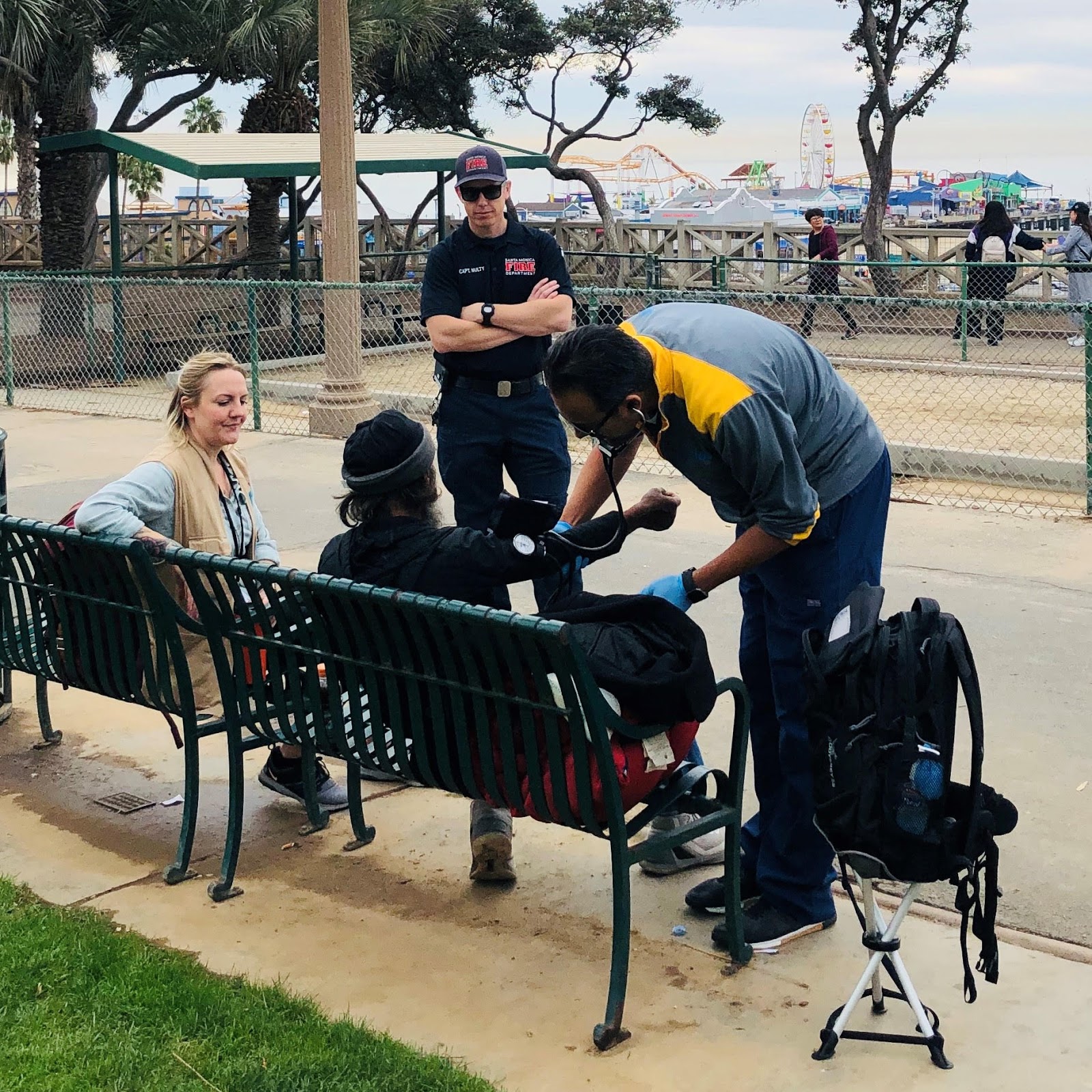Taking the History and Physical
Attempt to take a full medical and social history in the field. Alternatively, be prepared to forgo the traditional medical interview based on the patient’s tolerance or mental state. The outreach/case management partner may have relevant information to share which constitute elements of a medical and social history. For example, they may provide information about a patient’s past or current life, mental state, social situation, family situation, history of or current substance use, or recent hospitalizations.
Dr. King takes a history. Taken by Margaret Molloy
a) Taking the history: Consider the following guidelines for taking the patient’s history:
- Assess the hierarchy of patient needs based on physical and emotional tolerance.
- Pause and assess if any signs of distress are visible.
- Elicit current concerns.
- Be flexible as to the order of questions asked and let the patient set the pace.
- Resist the tendency to interrupt.
- Be willing to depart from the usual interview structure.
- Ask what things are needed first.
- Prepare to return another day to complete a full history, if necessary.
- Keep questions open ended and take notes or remember gaps in history to return to later. Individuals experiencing intoxication or psychotic symptoms may not be able to endure a full history. For example, it is difficult to follow a linear interview process with a person exhibiting a tangential thought process.
- Gather information on life history, social and family history and functional status, if possible.
- Use the information you have been given from social service partners if it is difficult for you to get this information yourself. It may be traumatizing for the person to repeat painful elements of their history.
- Probe further by asking“Is there anything else you’d like to tell me?”
b) Venice Family Clinic’s Homeless Clinic Progress note
Dr. Terri Brehove created a paper progress note that was used for street medicine and homeless outreach clinics. Although the Venice Family Clinic has transitioned to the use of the EMR system in the field and the clinic, our street medicine clinicians use Dr. Brehove’s social history as a guide to collect history elements that are pertinent to the population. The form also includes a section to freehand the SOAP note:
- Living situation
- Length of homelessness
- Family connections
- Income
- Meals: Need help?
- Transport: Need help?
- Alcohol use, drug use, IVDU: Past, current, never.
- Date of last tetanus vaccination
- Date of last PPD and presence of TB symptoms?
- Psychiatric history
- Date of last Pap smear and mammogram
- Sexual activity: Men or women and number of partners
- Condom use?
- Family Planning method
- Date of last HIV test
- Domestic violence: Past, present, none
- Smoking status
Street medicine innovators, Brett and Corrinne Feldman and Joel Hunt, present a helpful acronym to gather critical information for the history for unsheltered patients. Similar to the HEADSS acronym used for the adolescent interview, the HOUSED BEDS acronym can be used by multidisciplinary, integrated care team members to gather the information needed to provide patient-centered care that is responsive to an individual’s unique needs. The acronym stands for the following71:
- H: Homelessness
- O: Outreach
- U: Utilization (Health care, social services, judicial system)
- S: Salary
- E: Eat
- D: Drink
- B: Bathroom
- E: Encampment
- D: Daily routine
- S: Substance use
d) Vital Signs—Vital signs are one of the only objective metrics to assess a patient’s status in the field. They provide critical information needed in making life-saving decisions. It is important to address every abnormal vital sign. Primary vital signs to take in the field are:
- Blood pressure (consider transportation plans for hypertensive urgencies and do not hesitate to call 911 in the event of a hypertensive emergency)
- Pulse
- Temperature
- Oxygen saturation
- Weight (optional, due to the challenges of carrying a scale)
- Blood glucose (for patients with diabetes)
“Vital signs are vital.” —Dr. Coley King
Street Medicine Consideration: Tachycardia, in our observation, is the most common abnormal vital sign and is the most difficult to find causation. It is often asymptomatic. A mixture of sub-clinical dehydration and stimulant use is a frequent cause. The pulse will often normalize after having the patient drink a liter of water and waiting for 10 minutes.
Dr. King takes a history. Taken by Margaret Molloy
The team with support from the local fire department performs a field-based assessment. Taken by Brian Hardgrave of The People Concern.
Whenever possible, perform a head-to-toe examination for patients in the field. Because unsheltered patients often cannot access care in traditional settings,72 attempt to perform a comprehensive exam rather than a focused exam in the field. When needed, modify your physical exam approach to suit the needs of the setting and the patients’ preferences; for example, you may need to auscultate over clothing, or listen to heart sounds with a patient sitting up.
Street medicine often requires a great deal of medical and social detective work. You may be missing critical components of a patient’s history. Use the physical exam to make up for the information you would often have in the clinical setting with your housed patients.
Here is a list of helpful exam elements along with clinical pearls. The list is not meant to be comprehensive, rather a launching point for a meaningful street exam:
- General: Avoid statements like “well-nourished” if they are not accurate
- Eyes: Look out for signs like scleral icterus or conjunctival pallor. Make note of any baseline abnormalities like corneal scarring, blindness, etc.
- Mouth: Evaluate dentition from the start of the encounter. Poor dentition can be an opportunity to refer for dental care. Providing dental care can lead to engagement in more comprehensive care.
- Neck: Look for scarring, JVD, swelling. Palpate for lymphadenopathy.
- Chest: Lung sounds for patients who smoke heavily and live outdoors are often not “clear.”
- Cardiovascular: Again, tachycardia is common. Also pay close attention to the rhythm and listen for murmurs.
- Abdomen: Comment on any known or existing hernias. Avoid vigorous palpation for a patient with chronic pancreatitis. Pay attention for signs of hepatomegaly or ascites. Check for asterixis in patients with known cirrhosis.
- Lower extremities: Comment on any signs of stasis dermatitis, swelling, or ulceration. Perform a foot exam if your patient has diabetes. Be useful to a patient who needs assistance with overgrown, hypertrophic toenails. Tinea pedis is common, so check for scaling, erythema or maceration / fissuring between toes.
- Dermatologic exam: Include hair and nails. Scabies does not also limit itself to web spaces and can be diffuse. Check the hair for nits (head lice) and check the seams of collars and sleeves for body lice (insect or nits). Note any baseline clubbing of fingernails. Comment on any possible cancerous lesions on the face or other sun-exposed body parts. Ask about abscesses or skin infections for patients who use drugs. Note any baseline clubbing.
- Neurologic: Knowing your patient’s baseline orientation is critical because you will often be called upon to determine if the person is experiencing altered mental status. Note any resting or intention tremors. Observe for any baseline extrapyramidal signs such as abnormal movements of the face, mouth, trunk or limbs since this may give you an idea of what type of psychiatric medications your patient has used in the past.
- Mental status: These exam elements can be obtained during a conversation and do not require a physical exam. Many patients will decline a physical exam but are willing to talk. For a patient who is not ready for or is refusing a physical exam, you can easily gather the information needed for a complete mental status exam. Pay attention to appearance, behavior, speech, cognition, mood and affect, thought process and content, and insight and judgement. Ask about suicidal or homicidal ideation or plans if needed.
- Gait: Comment on use of or need for an assistive device for walking (crutches, walker, wheelchair). An assistive device can be a launching point for a discussion on needed medical care or an opportunity to be useful to a patient. Gait can also be an important part of a functional assessment and can determine what level of support your patient may need in housing. Remember to assess alcohol use for patients with balance and gait issues.


